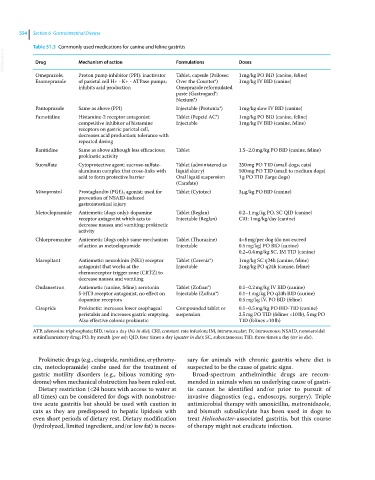Page 586 - Clinical Small Animal Internal Medicine
P. 586
554 Section 6 Gastrointestinal Disease
Table 51.3 Commonly used medications for canine and feline gastritis
VetBooks.ir Drug Mechanism of action Formulations Doses
Omeprazole; Proton pump inhibitor (PPI): inactivator Tablet, capsule (Prilosec 1 mg/kg PO BID (canine, feline)
Esomeprazole of parietal cell H+ ‐ K+ ‐ ATPase pumps; Over the Counter®) 1 mg/kg IV BID (canine)
inhibits acid production Omeprazole reformulated
paste (Gastrogard®;
Nexium®)
Pantoprazole Same as above (PPI) Injectable (Protonix®) 1 mg/kg slow IV BID (canine)
Famotidine Histamine‐2 receptor antagonist: Tablet (Pepcid AC®) 1 mg/kg PO BID (canine, feline)
competitive inhibitor of histamine Injectable 1 mg/kg IV BID (canine, feline)
receptors on gastric parietal cell,
decreases acid production; tolerance with
repeated dosing
Ranitidine Same as above although less efficacious; Tablet 1.5–2.0 mg/kg PO BID (canine, feline)
prokinetic activity
Sucralfate Cytoprotective agent: sucrose‐sulfate‐ Tablet (administered as 250 mg PO TID (small dogs, cats)
aluminum complex that cross‐links with liquid slurry) 500 mg PO TID (small to medium dogs)
acid to form protective barrier Oral liquid suspension 1 g PO TID (large dogs)
(Carafate)
Misoprostol Prostaglandin (PGE) 1 agonist: used for Tablet (Cytotec) 3 μg/kg PO BID (canine)
prevention of NSAID‐induced
gastrointestinal injury
Metoclopramide Antiemetic (dogs only): dopamine Tablet (Reglan) 0.2–1 mg/kg PO, SC QID (canine)
receptor antagonist which acts to Injectable (Reglan) CRI: 1 mg/kg/day (canine)
decrease nausea and vomiting; prokinetic
activity
Chlorpromazine Antiemetic (dogs only): same mechanism Tablet (Thorazine) 4–8 mg/per dog (do not exceed
of action as metoclopramide Injectable 0.5 mg/kg) PO BID (canine)
0.2–0.4 mg/kg SC, IM TID (canine)
Maropitant Antiemetic: neurokinin (NK1) receptor Tablet (Cerenia®) 1 mg/kg SC q24h (canine, feline)
antagonist that works at the Injectable 2 mg/kg PO q24h (canine, feline)
chemoreceptor trigger zone (CRTZ) to
decrease nausea and vomiting
Ondansetron Antiemetic (canine, feline): serotonin Tablet (Zofran®) 0.1–0.2 mg/kg IV BID (canine)
5‐HT3 receptor antagonist, no effect on Injectable (Zofran®) 0.1–1 mg/kg PO q24h BID (canine)
dopamine receptors 0.5 mg/kg IV, PO BID (feline)
Cisapride Prokinetic: increases lower esophageal Compounded tablet or 0.1–0.5 mg/kg PO BID‐TID (canine)
peristalsis and increases gastric emptying. suspension 2.5 mg PO TID (felines <10 lb), 5 mg PO
Also effective colonic prokinetic TID (felines >10 lb)
ATP, adenosine triphosphate; BID, twice a day (bis in die); CRI, constant rate infusion; IM, intramuscular; IV, intravenous; NSAID, nonsteroidal
antiinflammatory drug; PO, by mouth (per os); QID, four times a day (quater in die); SC, subcutaneous; TID, three times a day (ter in die).
Prokinetic drugs (e.g., cisapride, ranitidine, erythromy- sary for animals with chronic gastritis where diet is
cin, metoclopramide) canbe used for the treatment of suspected to be the cause of gastric signs.
gastric motility disorders (e.g., bilious vomiting syn- Broad‐spectrum anthelminthic drugs are recom-
drome) when mechanical obstruction has been ruled out. mended in animals when an underlying cause of gastri-
Dietary restriction (<24 hours with access to water at tis cannot be identified and/or prior to pursuit of
all times) can be considered for dogs with nonobstruc- invasive diagnostics (e.g., endoscopy, surgery). Triple
tive acute gastritis but should be used with caution in antimicrobial therapy with amoxicillin, metronidazole,
cats as they are predisposed to hepatic lipidosis with and bismuth subsalicylate has been used in dogs to
even short periods of dietary rest. Dietary modification treat Helicobacter‐associated gastritis, but this course
(hydrolyzed, limited ingredient, and/or low fat) is neces- of therapy might not eradicate infection.

